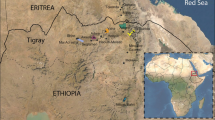Abstract
Landmasses can be classified as “islands” or “continents” mainly by geological, rather than geographical, criteria but the classification is still a bit arbitrary. We are presenting a statistical method (a modified Korcak analysis) where the area distribution reveals an intrinsic classification of landmasses. Based on this analysis, one can separate island, subcontinents and continents using only a spatial or geographical criterion, the area. Although not completely, this classification gives more or less the same groups like the ones based on geological criteria.



Similar content being viewed by others
Notes
The special Czech diacritical mark “č” in “Korčák” is usually omitted in English literature; therefore in this paper we are using “Korcak” for the method, exponent and dimension, but keeping the original way (Korčák) for the person.
Just for the sake of curiosity, these sizes are much bigger than the hypothetical island of the Greek mythology (Atlantis) fitting into the Aegean sea; the area of the biggest Aegean island, Crete is slightly above 8,000 km2.
References
Gaina C, Müller RD, Brown B, Ishihara T (2002) Microcontinent formation around Australia. Geol Soc Aust Spec Publ 22:399–410
GID (2010) Global island database. http://gid.unep-wcmc.org/
Hashemi M, Afzal P (2013) Identification of geochemical anomalies by using of number–size (N–S) fractal model in Bardaskan area, NE Iran. Arab J Geosci 6:4785–4794
Huynh HN, Chew LY (2011) Arc-fractal and the dynamic of coastal morphology. Fractals 19:141–162
Imre AR (2006) Artificial fractal dimension obtained by using perimeter–area relationship on digitalized images. Appl Math Comput 173:443–449
Imre AR, Bogaert J (2006) The Minkowski-Bouligand dimension and the interior-to-edge ratio of habitats. Fractals 14:49–53
Imre AR (2007) Systematic error in the determination of perimeter and area of off-lattice digitalized images. Int J Remote Sens 28:5071–5077
Imre AR, Cseh D, Neteler M, Rocchini D (2012a) Korcak dimension as a novel indicator of landscape fragmentation and re-forestation. Ecol Indic 11:1134–1138
Imre AR, Novotný J, Rocchini D (2012b) The Korcak-exponent: a non-fractal descriptor for landscape patchiness. Ecol Complex 12:70–74
Jang J, Jang YH (2012) Spatial distributions of islands in fractal surfaces and natural surfaces. Chaos, Solitons Fractals 45:1453–1459
Korčak J (1938) Deux types of fondamentaux de distribution statistique. Bull Inst Int Stat III:295–299
Mandelbrot BB (1967) How long is the coast of Britain? Statistical self-similarity and fractional dimension. Science 156:636–638
Mandelbrot BB (1975) Earth’s relief, shape and fractal dimension of coastlines, and number-area rule for islands. Proc Natl Acad Sci U S A 72:3825–3838
Mandelbrot BB (1982) The fractal geometry of nature. Freeman, New York
Müller RD, Gaina C, Roest WR, Hansen DL (2010) A recipe for microcontinent formation. Geology 29:203–206
Novotný J, Nosek V (2009) Nomothetic geography revisited: statistical distributions, their underlying principles, and inequality measures. Geografie 114:282–297
Richardson LF (1961) The problem of contiguity: an appendix to Statistic of Deadly Quarrels in General systems: Yearbook of the Society for the Advancement of General Systems Theory. Soc Gen Syst Res Ann Arbor Mich 6:139–187
Sasaki Y, Kobayashi N, Ouchi N, Matsushita M (2006) Fractal structure and statistics of computer-simulated and real landforms. J Phys Soc Jpn 75:074804
Schlüter T (2006) Geological atlas of Africa: With notes on stratigraphy, tectonics, economic geology. Geohazards and Geosites of Each Country. Springer-Verlag, Berlin, Ch. 4, pp 198–200
Scrutton RA (1976) Microcontinents and their significance. In: Drake CL (ed) Geodynamics: progress and prospects. American Geophysical Union, Washington, D.C., pp 177–189
Seuront L (2011) Fractals and multifractals in ecology and aquatic science. CRC Press, Boka Raton
Su F, Gao Y, Zhou C, Yang X, Fei X (2011) Scale effects of the continental coastline of China. J Geogr Sci 21:1101–1111
Sugihara G, May RM (1990) Applications of fractals in ecology. Trends Ecol Evol 5:79–86
Thielen DR, San José JJ, Montes RA, Lairet R (2010) Assessment of land use changes on woody cover and landscape fragmentation in the Orinoco savannas using fractal distributions. Ecol Indic 8:224–238
UNEP (2010) United Nations environment programme. http://islands.unep.ch/isldir.htm
Wessel P, Smith WHF (1996) A global self-consistent, hierarchical, high-resolution shoreline database. J Geophys Res 101:8741–8743
Acknowledgments
The author wishes to express his thanks to J. Novotný (Prague) and D. Rocchini (Trento) for the valuable discussions about Korcak analysis.
Author information
Authors and Affiliations
Corresponding author
Rights and permissions
About this article
Cite this article
Imre, A.R. Description of the area distribution of landmasses by Korcak exponent—the importance of the Arabic and Indian subcontinents in proper classification. Arab J Geosci 8, 3615–3619 (2015). https://doi.org/10.1007/s12517-014-1481-0
Received:
Accepted:
Published:
Issue Date:
DOI: https://doi.org/10.1007/s12517-014-1481-0




